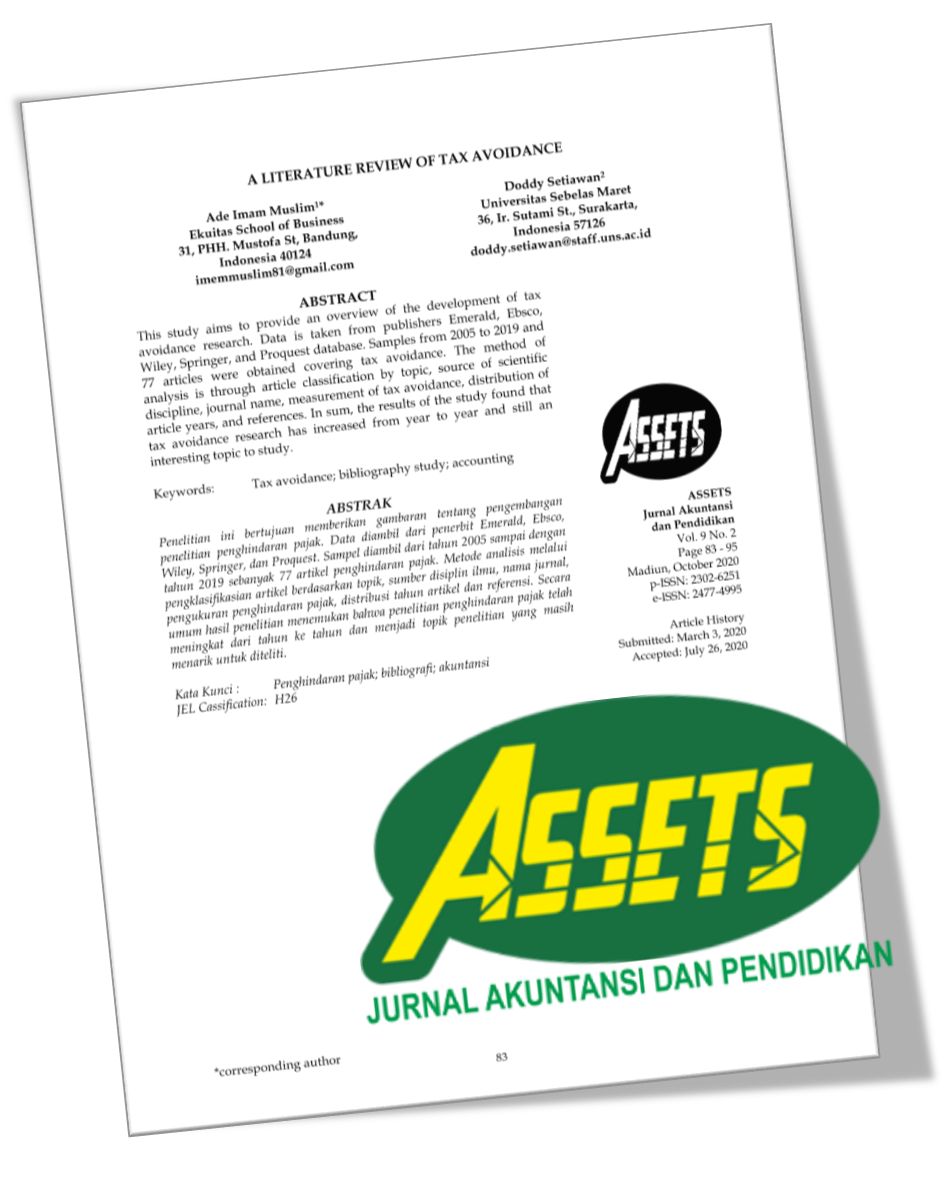Analisis Rasio Keuangan Sebagai Deteksi Kecurangan Laporan Laporan Keuangan Perusahaan Barang Konsumsi yang Terdaftar di Bursa Efek Indonesia
DOI:
https://doi.org/10.25273/jap.v7i1.2360Keywords:
Fraud, Fraudulent financial reporting, Financial ratio, IndonesiaAbstract
Downloads
References
Adrian, T., & Shin, H. S. (2010). Liquidity and leverage. Journal of Financial Intermediation, 19(3), 418–437. https://doi.org/10.1016/j.jfi.2008.12.002
Alâ€Najjar, B., & Hussainey, K. (2009). The association between dividend payout and outside directorships. Journal of Applied Accounting Research, 10(1), 4–19. https://doi.org/10.1108/09675420910963360
Badu, E. A. (2013). Determinants of Dividend Payout Policy of listed Financial Institutions in Ghana, 4(7), 185–191.
Beasley, M. S., Carcello, J. V., Hermanson, D. R., & Lapides, P. D. (2000). Fraudulent financial reporting: Consideration of industry traits and corporate governance mechanisms. Accounting Horizons, 14(4), 441–454. https://doi.org/10.2308/acch.2000.14.4.441
Cox, R. A. K., & Weirich, T. R. (2002). The stock market reaction to fraudulent financial reporting. Managerial Auditing Journal, 17(7), 374–382. https://doi.org/10.1108/02686900210437471
Dalnial, H., Kamaluddin, A., Sanusi, Z. M., & Khairuddin, K. S. (2014). Detecting Fraudulent Financial Reporting through Financial Statement Analysis, 2(1), 17–22. https://doi.org/10.12720/joams.2.1.17-22
Dani, R. M., Dickson, P. P., Sembilan, N., Adibah, W., Ismail, W., & Kamarudin, K. A. (2013). Can financial ratios explain the occurrence of fraudulent financial statements? The 5th International Conference on Financial Criminology (ICFC), (32), 345–354.
E. H. Feroz, ; K. Park, ; V. S. Pastena. (1991). The Financial and Market Effect of the SEC’s Accounting and Auditing Enforcement Releases. Journal of Accounting Research, 29, 107–142. https://doi.org/10.2478/aicue-2013-0019
Fama, E. F., Journal, T., Apr, N., & Fama, E. F. (2007). Agency Problems and the Theory of the Firm Agency Problems and the Theory of the Firm, 88(2), 288–307.
Goel, U., Chadha, S., & Sharma, A. K. (2015). Operating Liquidity and Financial Leverage: Evidences from Indian Machinery Industry. Procedia - Social and Behavioral Sciences, 189, 344–350. https://doi.org/10.1016/j.sbspro.2015.03.230
Jensen, M., & Meckling, W. (1976). Theory of the Firm: Managerial Behavior, Agency Costs, and Ownership Structure. J. Finan. Econ., 3pp, 305–60.
Kaminski, K. A., Wetzel, T. S., Guan, L., & Kaminski, K. A. (2004). Can financial ratios detect fraudulent financial reporting ? https://doi.org/10.1108/02686900410509802
Nia, S. H. (2015). Financial ratios between fraudulent and non-fraudulent firms : Evidence from Tehran Stock Exchange, 7(March), 38–44. https://doi.org/10.5897/JAT2014.0166
Persons, O. S. (1995). Using financial statement data to identify factor associated with fraudulent financial reporting. Journal of Applied Business Research.
Pustylnick, I. (2011a). Algorithm of Detection of Manipulations with Revenue and Retained Earnings in Financial Statements. SSRN Electronic Journal, 1–15. https://doi.org/10.2139/ssrn.1833804
Pustylnick, I. (2011b). Empirical Algorithm of Detection of Manipulation with Financial Statements. Journal of Accounting, Finance and Economics, 1(2), 54–67. https://doi.org/DOI:
Summers, S. L., & Sweeney, J. T. (1998). Fraudulently misstated financial statements and insider trading : An empirica analysis. The Accounting Review, 73(1), 131–146. https://doi.org/DOI:
Yazdanfar, D. (2013). Profitability determinants among micro firms: evidence from Swedish data. International Journal of Managerial Finance, 9(2), 151–160. https://doi.org/10.1108/17439131311307565
Zainudin, E. F., & Hashim, H. A. (2016). Detecting fraudulent financial reporting using financial ratio. Journal of Financial Reporting and Accounting, 14(2), 266–278. https://doi.org/10.1108/JFRA-05-2015-0053
Downloads
Published
Issue
Section
License
Perjanjian Lisensi dan Hak Cipta
Saat mengirimkan naskah ke jurnal, penulis menyatakan bahwa:
- Mereka diberi wewenang oleh rekan penulisnya untuk masuk ke dalam perjanjian ini.
- Karya yang dimaksud belum pernah diterbitkan secara resmi sebelumnya, kecuali dalam bentuk abstrak atau sebagai bagian dari kuliah, resensi, tesis, atau overlay jurnal yang diterbitkan.
- Karya yang dimaksud tidak sedang dipertimbangkan untuk diterbitkan di tempat lain,
- Publikasi karya yang dimaksud telah disetujui oleh semua penulis dan oleh otoritas yang bertanggung jawab - secara tahu sama tahu atau eksplisit - dari lembaga tempat pekerjaan itu dilakukan.
- Mereka mengamankan hak untuk mereproduksi materi apa pun yang telah diterbitkan atau dilindungi hak cipta di tempat lain.
- Mereka menyetujui lisensi dan perjanjian hak cipta berikut.
Hak Cipta
Penulis yang menerbitkan dengan ASSETS: Jurnal Akuntansi dan Pendidikan menyetujui persyaratan berikut:
- Penulis mempertahankan hak cipta dan memberikan jurnal hak publikasi pertama dengan karya yang secara bersamaan dilisensikan di bawah Lisensi Atribusi Creative Commons (CC BY-SA 4.0) yang memungkinkan orang lain untuk berbagi karya dengan pengakuan kepenulisan karya dan publikasi awal di jurnal ini.
- Penulis dapat masuk ke dalam pengaturan kontrak tambahan yang terpisah untuk distribusi non-eksklusif dari versi jurnal yang diterbitkan dari karya tersebut (misalnya, mempostingnya ke repositori institusional atau menerbitkannya dalam sebuah buku), dengan pengakuan publikasi awalnya di jurnal ini.
- Penulis diizinkan dan didorong untuk memposting karya mereka secara daring (misalnya di repositori institusional atau di situs web mereka) sebelum dan selama proses pengiriman, karena dapat menghasilkan pertukaran yang produktif, serta kutipan lebih awal dan lebih besar dari karya yang diterbitkan.
License and Copyright Agreement
In submitting the manuscript to the journal, the authors certify that:
- Their co-authors authorize them to enter into these arrangements.
- The work described has not been formally published before, except as an abstract or part of a published lecture, review, thesis, or overlay journal.
- That it is not under consideration for publication elsewhere,
- That its publication has been approved by all the author(s) and by the responsible authorities – tacitly or explicitly – of the institutes where the work has been carried out.
- They secure the right to reproduce any material already published or copyrighted elsewhere.
- They agree to the following license and copyright agreement.
Copyright
Authors who publish with ASSETS: Jurnal Akuntansi dan Pendidikan agree to the following terms:
- Authors retain copyright and grant the journal right of first publication with the work simultaneously licensed under a Creative Commons Attribution License (CC BY-SA 4.0) that allows others to share the work with an acknowledgment of the work's authorship and initial publication in this journal.
- Authors can enter into separate, additional contractual arrangements for the non-exclusive distribution of the journal's published version of the work (e.g., post it to an institutional repository or publish it in a book), with an acknowledgment of its initial publication in this journal.
- Authors are permitted and encouraged to post their work online (e.g., in institutional repositories or on their website) before and during submission, as it can lead to productive exchanges and earlier and more extraordinary citations of published work.

ASSETS: Jurnal Akuntansi dan Pendidikan is licensed under a Creative Commons Attribution-ShareAlike 4.0 International License.










